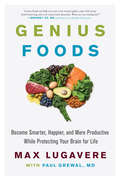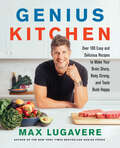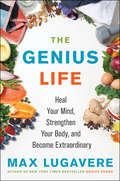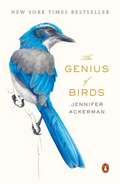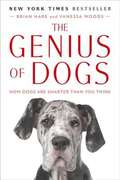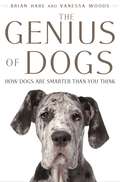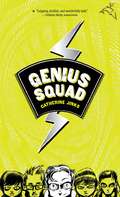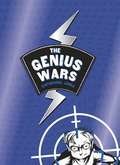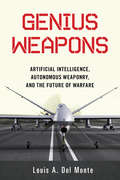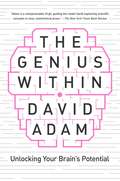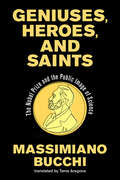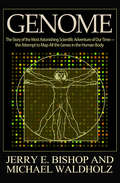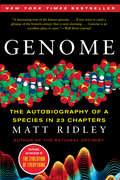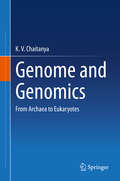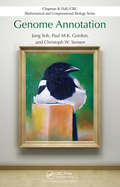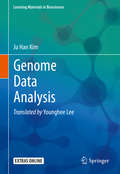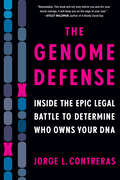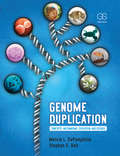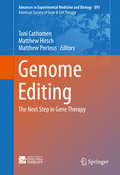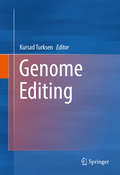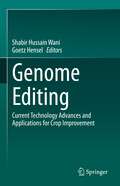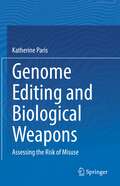- Table View
- List View
Genius Foods: Become Smarter, Happier, and More Productive While Protecting Your Brain for Life
by Max Lugavere Paul GrewalDiscover the critical link between your brain and the food you eat and change the way your brain ages, in this cutting-edge, practical guide to eliminating brain fog, optimizing brain health, and achieving peak mental performance from media personality and leading voice in health Max Lugavere. After his mother was diagnosed with a mysterious form of dementia, Max Lugavere put his successful media career on hold to learn everything he could about brain health and performance. For the better half of a decade, he consumed the most up-to-date scientific research, talked to dozens of leading scientists and clinicians around the world, and visited the country’s best neurology departments—all in the hopes of understanding his mother’s condition. Now, in Genius Foods, Lugavere presents a comprehensive guide to brain optimization. He uncovers the stunning link between our dietary and lifestyle choices and our brain functions, revealing how the foods you eat directly affect your ability to focus, learn, remember, create, analyze new ideas, and maintain a balanced mood. Weaving together pioneering research on dementia prevention, cognitive optimization, and nutritional psychiatry, Lugavere distills groundbreaking science into actionable lifestyle changes. He shares invaluable insights into how to improve your brain power, including the nutrients that can boost your memory and improve mental clarity (and where to find them);the foods and tactics that can energize and rejuvenate your brain, no matter your age;a brain-boosting fat-loss method so powerful it has been called “biochemical liposuction”; andthe foods that can improve your happiness, both now and for the long term.With Genius Foods, Lugavere offers a cutting-edge yet practical road map to eliminating brain fog and optimizing the brain’s health and performance today—and decades into the future.
Genius Kitchen: Over 100 Easy and Delicious Recipes to Make Your Brain Sharp, Body Strong, and Taste Buds Happy (Genius Living #3)
by Max LugavereCombining the dietary recommendations in his bestselling Genius Foods and the lifestyle recommendations of The Genius Life, Genius Kitchen features shockingly delicious, nutrient-packed recipes that will energize your mind, strengthen your body, and pave a path to health that you’ll feel with the first bite. Max Lugavere’s debut book Genius Foods was groundbreaking, providing much-needed information on brain health that was embraced by thousands, and became an instant New York Times bestseller. His second book, The Genius Life, introduced an easy-to-implement protocol for strengthening your body and mind. This is the follow-up fans have been waiting for: the companion cookbook, filled with over 100 delicious recipes to help you lose weight, feel great, and reach optimum health.Inspired by traditions from around the globe, the 100-plus recipes and stunning photographs in Genius Kitchen feature an international twist, with bold flavors that favor simplicity and quality of ingredients over complexity and quantity. In addition, Max lists the basic, healthy ingredients and tools that are essential for a well-stocked kitchen and pantry, and offers techniques and best practices for healthy cooking and eating well on a budget. Max wants everyone to be well and enjoy great food—a legacy imparted on him by the tragic health of his mother. Part cookbook, part wellness guide, Genius Kitchen provides key insights that make healthy eating a breeze. Max explains the importance of whole, fresh foods, how various nutrients work together keep you healthy, and how to get fit without counting calories. Breaking down each meal component, Max explains the art and science of nutrition without the dogma, so that you can feel your best every day without sacrificing your love of eating. Whether you are a novice cook or seasoned in the kitchen; just beginning the journey to wellness, or health conscious but wanting to up your game, everyone will benefit from the information presented in Genius Kitchen—and enjoy some epic food in the process.
The Genius Life: Heal Your Mind, Strengthen Your Body, and Become Extraordinary (Genius Living #2)
by Max LugavereThe author of the New York Times bestselling Genius Foods is back with a lifestyle program for resetting your brain and body to its “factory settings,” to help fight fatigue, anxiety, and depression and to optimize cognitive health for a longer and healthier life.The human body was honed under conditions that no longer exist. The modern world has changed dramatically since our days as hunter gatherers, and it has caused widespread anxiety, stress, and disease, leaving our brains in despair. But science proves that the body and brain can be healed with the intervention of lifestyle protocols that help us to regain our cognitive birthright.In The Genius Life, Lugavere expands the Genius Foods plan, which focused on nutrition and how it affects brain health, and expands it to encompass a full lifestyle protocol. We know now that the health of our brains—including our cognitive function and emotional wellness—depend on the health of our gut, endocrine, cardiac and nervous systems as there is a constant feedback loop between all systems. Drawing on globe-spanning research into circadian biology, psychology, dementia prevention, cognitive optimization, and exercise physiology, The Genius Life shows how to integrate healthy choices in all aspects of our daily routines: eating, exercising, sleeping, detoxing, and more to create a healthy foundation for optimal cognitive health and performance. Among Max’s groundbreaking findings, you will discover:· A trick that gives you the equivalent of a “marathon” workout, in 10 minutes· How to get the benefits of an extra 1-2 servings of veggies daily without eating them· The hidden chemicals in your home that could be making you fat and sick· How to boost melatonin levels by up to 58% for deeper sleep without supplementsThe book features an achievable prescriptive 21-day plan for Genius Living that includes daily workouts, meal plans, and meal prep tips, and accompanied with helpful suggestions for healthy swaps and snacks
The Genius of Birds
by Jennifer Ackerman<P>Birds are astonishingly intelligent creatures. In fact, according to revolutionary new research, some birds rival primates and even humans in their remarkable forms of intelligence. Like humans, many birds have enormous brains relative to their size. Although small, bird brains are packed with neurons that allow them to punch well above their weight. <P> In The Genius of Birds, acclaimed author Jennifer Ackerman explores the newly discovered brilliance of birds and how it came about. As she travels around the world to the most cutting-edge frontiers of research-- the distant laboratories of Barbados and New Caledonia, the great tit communities of the United Kingdom and the bowerbird habitats of Australia, the ravaged mid-Atlantic coast after Hurricane Sandy and the warming mountains of central Virginia and the western states--Ackerman not only tells the story of the recently uncovered genius of birds but also delves deeply into the latest findings about the bird brain itself that are revolutionizing our view of what it means to be intelligent. <P>Consider, as Ackerman does, the Clark's nutcracker, a bird that can hide as many as 30,000 seeds over dozens of square miles and remember where it put them several months later; the mockingbirds and thrashers, species that can store 200 to 2,000 different songs in a brain a thousand times smaller than ours; the well-known pigeon, which knows where it's going, even thousands of miles from familiar territory; and the New Caledonian crow, an impressive bird that makes its own tools. <P>But beyond highlighting how birds use their unique genius in technical ways, Ackerman points out the impressive social smarts of birds. They deceive and manipulate. They eavesdrop. They display a strong sense of fairness. They give gifts. They play keep-away and tug-of-war. They tease. They share. They cultivate social networks. They vie for status. They kiss to console one another. They teach their young. They blackmail their parents. They alert one another to danger. They summon witnesses to the death of a peer. They may even grieve. <P>This elegant scientific investigation and travelogue weaves personal anecdotes with fascinating science. Ackerman delivers an extraordinary story that will both give readers a new appreciation for the exceptional talents of birds and let them discover what birds can reveal about our changing world. Incredibly informative and beautifully written, The Genius of Birds richly celebrates the triumphs of these surprising and fiercely intelligent creatures. <P><b>A New York Times Bestseller</b>
The Genius of Dogs
by Brian HareBrian Hare, dog researcher, evolutionary anthropologist, and founder of the Duke Canine Cognition Center, and Vanessa Woods offer revolutionary new insights into dog intelligence and the interior lives of our smartest pets. In the past decade, we have learned more about how dogs think than in the last century. Breakthroughs in cognitive science, pioneered by Brian Hare have proven dogs have a kind of genius for getting along with people that is unique in the animal kingdom. Brian Hare's stunning discovery is that when dogs domesticated themselves as early as 40,000 years ago they became far more like human infants than their wolf ancestors. Domestication gave dogs a whole new kind of social intelligence. This finding will change the way we think about dogs and dog training—indeed, the revolution has already begun. Hare's seminal research has led him to work with every kind of dog from the tiniest shelter puppy to the exotic New Guinea singing dog, from his own childhood dog, Oreo, to the most fashionable schnoodle. The Genius of Dogs is nothing less than the definitive dog book of our time by the researcher who started a revolution. .
The Genius of Dogs
by Brian Hare Vanessa WoodsFor readers of Inside of a Dog by Alexandra Horowitz, this New York Times bestseller offers mesmerizing insights into the interior lives of our smartest petsIn the past decade, we have learned more about how dogs think than in the last century. Breakthroughs in cognitive science, pioneered by Brian Hare, have proven dogs have a kind of genius for getting along with people that is unique in the animal kingdom. This dog genius revolution is transforming how we live and work with our canine friends, including how we train them. Does your dog feel guilt? Is she pretending she can't hear you? Does she want affection--or just your sandwich? In The Genius of Dogs, Brian Hare and Vanessa Woods lay out what discoveries at the Duke Canine Cognition Lab and other research facilities around the world are revealing about how your dog thinks and how we humans can have even deeper relationships with our best four-legged friends.
The Genius of Dogs: How Dogs Are Smarter than You Think
by Brian Hare Vanessa WoodsHare, dog researcher, evolutionary anthropologist, and founder of the Duke Canine Cognition Center, offers revolutionary new insights into dog intelligence and the interior lives of the smartest pets.
Genius Squad
by Catherine JinksNow that the Axis Institute for World Domination has been blown up; the founder, Dr. Phineas Darkkon, has died; and Prosper English (who enrolled Cadel in the first place) is in jail for myriad offenses, Cadel Piggott has round-the-clock surveillance so he'll be safe until he testifies against Prosper English. But nobody seems to want Cadel. Not Fiona, his social worker; not Saul Greeniaus, the detective assigned to protect him. When he is approached by the head of Genius Squad--a group formed to investigate GenoME, one of Darkkon's pet projects--Cadel is dubious Genius Squad can offer him a real home and all the technology his heart desires. But why can't he bring himself to tell Saul what the group is really up to? And how can Genius Squad protect Cadel once Prosper English breaks out of jail?
The Genius Wars
by Catherine JinksBoy-genius Cadel Piggot has a new name (Cadel Greenaius), a new family, and a new life. No more illegal hacking, no more false identities, and most of all, no more Prosper English. But when his best friend Sonja is attacked, it's up to him to figure out who was behind it. Before he knows it, Cadel is crossing oceans and continents, barrelling back into the depths of the criminal activity he thought he'd left behind, and coming face to face with Prosper English once again. Can Cadel track down Prosper before it's too late? And what rules will he have to break in the process?
Genius Weapons: Artificial Intelligence, Autonomous Weaponry, and the Future of Warfare
by Louis A. Del MonteA technology expert describes the ever-increasing role of artificial intelligence in weapons development, the ethical dilemmas these weapons pose, and the potential threat to humanity.Artificial intelligence is playing an ever-increasing role in military weapon systems. Going beyond the bomb-carrying drones used in the Afghan war, the Pentagon is now in a race with China and Russia to develop "lethal autonomous weapon systems" (LAWS). In this eye-opening overview, a physicist, technology expert, and former Honeywell executive examines the advantages and the potential threats to humanity resulting from the deployment of completely autonomous weapon systems. Stressing the likelihood that these weapons will be available in the coming decades, the author raises key questions about how the world will be impacted. Though using robotic systems might lessen military casualties in a conflict, one major concern is: Should we allow machines to make life-and-death decisions in battle? Other areas of concern include the following: Who would be accountable for the actions of completely autonomous weapons--the programmer, the machine itself, or the country that deploys LAWS? When warfare becomes just a matter of technology, will war become more probable, edging humanity closer to annihilation? What if AI technology reaches a "singularity level" so that our weapons are controlled by an intelligence exceeding human intelligence?Using vivid scenarios that immerse the reader in the ethical dilemmas and existential threats posed by lethal autonomous weapon systems, the book reveals that the dystopian visions of such movies as The Terminator and I, Robot may become a frightening reality in the near future. The author concludes with concrete recommendations, founded in historical precedent, to control this new arms race.
The Genius Within: Unlocking Our Brain's Potential
by David AdamFollowing the success of The Man Who Couldn’t Stop, David Adam now expounds on the latest research into intelligence, revealing how this revolution in neuroscience will help us access the untapped potential locked within us all. What if you have more intelligence than you realize? What if there is a genius inside you, just waiting to be released? And what if the route to better brain power is not hard work or thousands of hours of practice but to simply swallow a pill? In The Genius Within, David Adam explores the groundbreaking neuroscience of cognitive enhancement that is changing the way the brain and the mind works—to make it better, sharper, more focused and, yes, more intelligent. He considers how we measure and judge intelligence, taking us on a fascinating tour of the history of brain science and medicine, from gentlemen scientist brain autopsy clubs to case studies of mental health patients with extraordinary savant abilities. In addition to reporting on the latest research and fascinating case studies, David also goes on his own personal journey to investigate the possibilities of neuroenhancement, using himself as a guinea pig for smart pills and electrical brain stimulation in order to improve his IQ scores and cheat his way into MENSA. Getting to the heart of how we think about intelligence and mental ability, The Genius Within plunges into deep ethical, neuroscientific, and historical pools of enquiry about the science of brain function, untapping potential, and what it means for all of us. Going to the heart of how we consider, measure, and judge mental ability, The Genius Within asks difficult questions about the science that could rank and define us, and inevitably shape our future.
Geniuses, Heroes, and Saints: The Nobel Prize and the Public Image of Science
by Massimiano BucchiA rich account of the world&’s leading science prize told through the lives it has changed, the controversies it has generated, and the impact it has made on the public.In a world where the work of science largely remains inscrutable to the general public, the Nobel Prize confers a degree of intelligibility like no other honor. Our best-known and most prestigious award for individual scientific achievement, the Nobel attaches a brilliant face to a story of profound discovery, making moving headlines. In Geniuses, Heroes, and Saints, Massimiano Bucchi tells an equally compelling story of the Nobel&’s transformation of science into an epic pursuit legible both to the field and to the public, bound up with the currents of historical change.Three main narratives characterize the Nobel. The scientist as genius, portrayed as a creative visionary, an exceptional intellect reflecting a solitary and romantic ideal of great communicative impact. The scientist as national hero acts as a surrogate of competition among nations in a peaceful, rational contest. The scientist as saint shines with moral exceptionality, a figure worthy of celebration and worship, known for virtues such as modesty, humility, and total dedication, body and soul, to the scientific enterprise. Whether the recipient was Albert Einstein or a countryside doctor toiling for years in obscurity, whether the prize was worthily given or awarded to work later disproved, or whether we even remember the honorees today, the Nobel defined the image of science in the twentieth century, Bucchi shows, an image that still lives in all sorts of fascinating ways today.
Genome: The Story of the Most Astonishing Scientific Adventure of Our Time - The Attempt to Map All the Genes in the Human Body
by Jerry E. Bishop Michael WaldholzBy far the best popular work written about the impact of molecular biology on science. An incisive, thoughtful and thorough work that educates and entertains.
Genome: The Story of the Most Astonishing Scientific Adventure of Our Time—the Attempt to Map All the Genes in the Human Body (Saber Mas Ser.)
by Jerry E. Bishop Michael WaldholzAn &“invaluable [and] highly readable&” account of the quest to map our DNA, the blueprint for life—and what it means for our future ( The Philadelphia Inquirer).Genome tells the story of the most ambitious scientific adventure of our time. By gradually isolating and identifying all the genes in the human body—the blueprint for life—scientists are closing in on the ability to effectively treat and prevent nearly every disease that strikes man, from muscular dystrophy, diabetes, and cancer to heart ailments, alcoholism, and even mental illness. Such discoveries will change the course of human life. At the same time, they raise profound ethical questions that have tremendous implications: Can insurance companies demand genetic tests to determine who poses a health risk? Should parents be able to choose their baby&’s sex or eye color? Will employers screen out potential employees who are genetically susceptible to occupational health problems? An exciting true tale of discovery that is revolutionizing our world, Genome helps us understand our future.
Genome: The Autobiography of a Species in 23 Chapters (P. S. Series)
by Matt RidleyThe genome's been mapped.<P> But what does it mean?<P> Arguably the most significant scientific discovery of the new century, the mapping of the twenty-three pairs of chromosomes that make up the human genome raises almost as many questions as it answers. Questions that will profoundly impact the way we think about disease, about longevity, and about free will. Questions that will affect the rest of your life.<P> Genome offers extraordinary insight into the ramifications of this incredible breakthrough. By picking one newly discovered gene from each pair of chromosomes and telling its story, Matt Ridley recounts the history of our species and its ancestors from the dawn of life to the brink of future medicine. From Huntington's disease to cancer, from the applications of gene therapy to the horrors of eugenics, Matt Ridley probes the scientific, philosophical, and moral issues arising as a result of the mapping of the genome. It will help you understand what this scientific milestone means for you, for your children, and for humankind.<P> Chosen for Mark Zuckerberg's "A Year of Books"
Genome and Genomics: From Archaea to Eukaryotes
by K. V. ChaitanyaThis book provides a detailed and up-to-dated information on the genomes belonging to three major life forms on Earth – archaea, prokaryotes and eukaryotes. Each section describes about the genome of a specific group of organisms, such as viruses, archaea, bacteria, eukaryotes and organellar genomes. Individual chapters provide details of their organization, structure, evolution, sequencing strategies and functions. Further, this book discusses the technologies that are applied for genome sequencing; assembly, annotation and gene prediction. Other topics include the genomes of important model organisms, mitochondria genome of Neanderthal fossil, etc. This book also examines the evolution of chloroplast and mitochondria genomes by comparing with bacteria, addresses the diseases that occur in humans due to the mutations in mitochondrial genome, gene therapy and engineering of chloroplast and mitochondrial genomes. Lastly, it features an overview of the role of proteomics, exposomics, connectomics, metabolomics, and microbiomics. This book is a fascinating read for students, lecturers and researchers in the field of genetics, genomics, microbiology and life sciences.
Genome Annotation (Chapman & Hall/CRC Computational Biology Series #46)
by Jung Soh Paul M.K. Gordon Christoph W. SensenThe success of individualized medicine, advanced crops, and new and sustainable energy sources requires thoroughly annotated genomic information and the integration of this information into a coherent model. A thorough overview of this field, Genome Annotation explores automated genome analysis and annotation from its origins to the challenges of next-generation sequencing data analysis.The book initially takes you through the last 16 years since the sequencing of the first complete microbial genome. It explains how current analysis strategies were developed, including sequencing strategies, statistical models, and early annotation systems. The authors then present visualization techniques for displaying integrated results as well as state-of-the-art annotation tools, including MAGPIE, Ensembl, Bluejay, and Galaxy. They also discuss the pipelines for the analysis and annotation of complex, next-generation DNA sequencing data. Each chapter includes references and pointers to relevant tools. As very few existing genome annotation pipelines are capable of dealing with the staggering amount of DNA sequence information, new strategies must be developed to accommodate the needs of today’s genome researchers. Covering this topic in detail, Genome Annotation provides you with the foundation and tools to tackle this challenging and evolving area. Suitable for both students new to the field and professionals who deal with genomic information in their work, the book offers two genome annotation systems on an accompanying downloadable resources.
GENOME-BASED DIAGNOSTICS Clarifying Pathways to Clinical Use
by Steve Olson Adam C. Berger RapporteursThe sequencing of the human genome and the identification of associations between specific genetic variants and diseases have led to an explosion of genomic-based diagnostic tests. These tests have the potential to direct therapeutic interventions, predict risk or onset of disease, or detect residual disease. As research progresses and an increasing number of associations are found, further tests will be developed that can aid in providing personalized treatment options for patients. However, the adoption of genomic diagnostic tests by health care providers has been limited due to a lack of evidence regarding the clinical utility of many tests. Health funders and practitioners lack the data necessary to distinguish which tests can improve practice or the clinical settings in which tests will provide the greatest value. The Roundtable on Translating Genomic-Based Research for Health held a workshop in November 2010 to determine what evidence is needed and how it is viewed by different stakeholders in order to develop genomic diagnostic tests of clinical value. Genome-Based Diagnostics summarizes the presentations and discussions that took place throughout the workshop. Two presentations, in particular, sparked extensive discussion. One presentation proposed that all genomic diagnostic tests be reviewed and approved by the Food and Drug Administration. The other observed that venture capitalists are no longer investing substantially in the development of genomic diagnostic tests because of a lack of clarity surrounding regulatory and reimbursement pathways. Both presentations suggested the need for major changes in the systems used to develop, regulate, and reimburse genomic diagnostic tests. The report also presents the perspectives of different stakeholders in the development of genomic diagnostic tests. Each stakeholder group has a different set of needs and issues of importance, yet commonalities among them are apparent, such as the need to put patients and health outcomes at the center of discussion and action.
Genome Data Analysis (Learning Materials in Biosciences)
by Ju Han KimThis textbook describes recent advances in genomics and bioinformatics and provides numerous examples of genome data analysis that illustrate its relevance to real world problems and will improve the reader’s bioinformatics skills. Basic data preprocessing with normalization and filtering, primary pattern analysis, and machine learning algorithms using R and Python are demonstrated for gene-expression microarrays, genotyping microarrays, next-generation sequencing data, epigenomic data, and biological network and semantic analyses. In addition, detailed attention is devoted to integrative genomic data analysis, including multivariate data projection, gene-metabolic pathway mapping, automated biomolecular annotation, text mining of factual and literature databases, and integrated management of biomolecular databases. The textbook is primarily intended for life scientists, medical scientists, statisticians, data processing researchers, engineers, and other beginners in bioinformatics who are experiencing difficulty in approaching the field. However, it will also serve as a simple guideline for experts unfamiliar with the new, developing subfield of genomic analysis within bioinformatics.
The Genome Defense: Inside the Epic Legal Battle to Determine Who Owns Your DNA
by Jorge L. ContrerasIn this riveting, behind-the-scenes courtroom drama, a brilliant legal team battles corporate greed and government overreach for our fundamental right to control our genes. When attorney Chris Hansen learned that the U.S. government was issuing patents for human genes to biotech companies, his first thought was, How can a corporation own what makes us who we are? Then he discovered that women were being charged exorbitant fees to test for hereditary breast and ovarian cancers, tests they desperately needed—all because Myriad Genetics had patented the famous BRCA genes. So he sued them. Jorge L. Contreras, one of the nation&’s foremost authorities on human genetics law, has devoted years to investigating the groundbreaking civil rights case known as AMP v. Myriad. In The Genome Defense Contreras gives us the view from inside as Hansen and his team of ACLU lawyers, along with a committed group of activists, scientists, and physicians, take their one-in-a-million case all the way to the U.S. Supreme Court. Contreras interviewed more than a hundred key players involved in all aspects of the case—from judges and policy makers to ethicists and genetic counselors, as well as cancer survivors and those whose lives would be impacted by the decision—expertly weaving together their stories into a fascinating narrative of this pivotal moment in history. The Genome Defense is a powerful and compelling story about how society must balance scientific discovery with corporate profits and the rights of all people.
Genome Duplication
by Melvin DePamphilis Stephen D. BellGenome Duplication provides a comprehensive and readable overview of the underlying principles that govern genome duplication in all forms of life, from the simplest cell to the most complex multicellular organism.?Using examples from the three domains of life - bacteria, archaea, and eukarya - Genome Duplication shows how all living organisms store their genome as DNA and how they all use the same evolutionary-conserved mechanism to duplicate it: semi-conservative DNA replication by the replication fork. The text shows how the replication fork determines where organisms begin genome duplication, how they produce a complete copy of their genome each time a cell divides, and how they link genome duplication to cell division.?Genome Duplication explains how mistakes in genome duplication are associated with genetic disorders and cancer, and how understanding genome duplication, its regulation, and how the mechanisms differ between different forms of life, is critical to the understanding and treatment of human disease.
Genome Editing
by Toni Cathomen Matthew Hirsch Matthew PorteusThis comprehensive volume explores human genetic engineering its pre-clinical and clinical applications, current developments, and as treatment for hereditary diseases. It presents and evaluates the most recent advances in the understanding of mammalian host DNA repair mechanisms, such as double-strand break induced gene targeting and mutagenesis, the development of zinc-finger nucleases, genome editing for neuromuscular diseases, phase integrases, triplex forming oligonucleotides and peptide nucleic acids, aptamer-guided gene targeting, AAV gene editing via DSB repair, engineered nucleases and trinucleotide repeat diseases, and creation of HIV-resistant cells. The expertly authored chapters contextualize current developments within the history of genome editing while also discussing the current and potential safety concerns of this rapidly growing field. Genome Editing: The Next Step in Gene Therapy, the latest volume in the American Society of Gene and Cell Therapy series, deftly illuminates the potential of genetic engineering technology to eradicate today's deadliest and most prolific diseases. It is ideal reading for clinicians and researchers in genetics and immunology.
Genome Editing
by Kursad TurksenThis timely volume explores the use of CRISPR-Cas9 for genome editing, presenting cutting-edge techniques and their applications in treatment of disease. The chapters describe latest methods such as use of targetable nucleases, investigation of the non-coding genome, mouse genome editing, increasing of knock-in efficiency in mouse zygotes, and generation of reporter stem cells; the text contextualizes these methods in treatment of cardiovascular disease, diabetes mellitus, retinitis pigmentosa, and others. The final chapters round out the book with a discussion of controversies and future directions. Genome Editing is an essential, of-the-moment contribution to this rapidly growing field. Drawing from a wealth of international perspectives, it presents novel techniques and applications for the engineering of the human genome. This book is essential reading for all clinicians and researchers in stem cells, regenerative medicine, genomics, biochemical and biomedical engineering- especially those interested in learning more about genome editing and applying it in a targeted, specific way.
Genome Editing: Current Technology Advances and Applications for Crop Improvement
by Shabir Hussain Wani Goetz HenselOver the last few decades, various techniques have been developed to alter the properties of plants and animals. While the targeted transfer of recombinant DNA into crop plants remains a valuable tool to achieve a desirable breeding outcome, integration of transgenes into the host genome has been random, which in part, leads to reduced acceptance of GMOs by the general population in some parts of the world. Likewise, methods of induced mutagenesis, such as TILLING, have the disadvantage that many mutations are induced per plant, which has to be removed again by expensive backcrossing. Advances in genome sequencing have provided more and more information on differences between susceptible and resistant varieties, which can now be directly targeted and modified using CRISPR/Cas9 technology. By selecting specific gRNAs occurrence of off-target modifications are comparatively low. ZFNs and TALENs- based approaches required re-engineering a new set of assembled polypeptides for every new target site for each experiment. The difficulty in cloning and protein engineering prevented these tools from being broadly adopted by the scientific community. Compared to these technologies, designing the CRISPR toolbox is much simpler and more flexible. CRISPR/Cas9 is versatile, less expensive and highly efficient. It has become the most widely used technology for genome editing in many organisms.Since its inception as a powerful genome-editing tool in late 2012, this breakthrough technology has completely changed how science is performed. The first few chapters in this book introduce the basic concept, design and implementation of CRISPR/Cas9 for different plant systems. They are followed by in-depth discussions on the legal and bio-safety issues accompanying commercialization and patenting of this emerging technology. Lastly, this book covers emerging areas of new tools and potential applications. We believe readers, novice and expert alike, will benefit from this all-in-one resource on genome editing for crop improvement.Chapter 17 is available open access under a Creative Commons Attribution 4.0 International License via link.springer.com.
Genome Editing and Biological Weapons: Assessing the Risk of Misuse
by Katherine ParisThis monograph introduces current genome editing technologies—clustered regularly interspaced short palindromic repeat (CRISPR)-CRISPR-associated (Cas) systems, transcription activator-like effector nucleases (TALENs), and zinc-finger nucleases (ZFNs)—and provides an assessment of the risk of misuse of these technologies based on the following parameters: accessibility, ease of misuse, magnitude of potential harm, and imminence of potential misuse. The findings from this assessment are applied to analyze and evaluate the threat posed by the intentional misuse of genome editing technologies to develop biological weapons. Furthermore, the book discusses the implications of misuse for different applications of genome editing, such as making existing pathogens more dangerous, modifying the human microbiome, weaponizing gene drives, engineering super soldiers, and augmenting the general population to confer economic advantages. Technologies that enable genome editing with programmable nucleases—including CRISPR, TALEN, and ZFN—allow for the precise genetic modification of organisms and cultured cells. While these technologies are used for a variety of beneficial applications, intelligence and defense experts have raised concerns that genome editing technologies, especially CRISPR, could be misused to develop new and improved biological weapons. Furthermore, experts worry that the number and type of actors who could potentially misuse genome editing is dramatically increasing given the democratization of biology, which is allowing biology to become more accessible to everyone including nonexperts. The book provides a comprehensive assessment of how feasible it is for users with different levels of knowledge and skill to acquire and then to apply the technologies to develop a biological weapon. It also provides an assessment of governability and a tailored set of recommendations that address security concerns. These recommendations are sensitive to the cost-benefit trade-off of regulating genome editing technologies. The book targets researchers as well as intelligence analysts, defense and security personnel, and policymakers.
